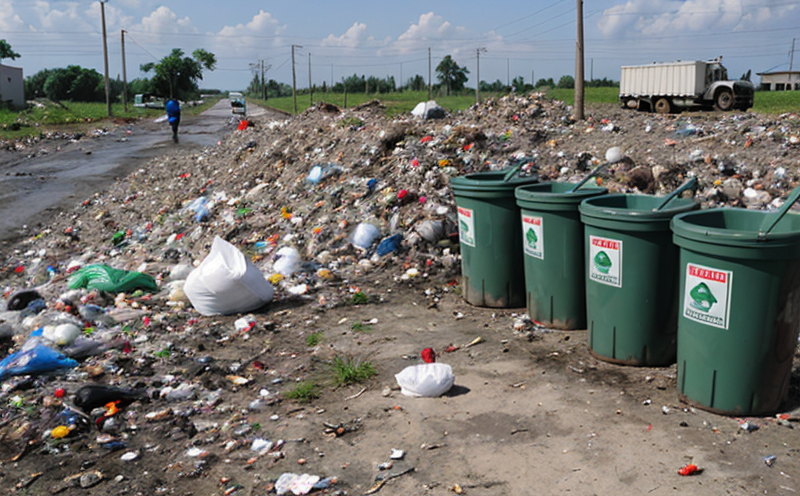EN 12457-3 Leaching of Monolithic Solid Waste Test
The EN 12457-3 standard specifies the procedures for determining the leachable content from monolithic solid waste materials. This test is essential in evaluating the environmental impact of waste materials, particularly those intended for disposal or recycling. The procedure aims to quantify hazardous substances that may be released into the environment following landfilling or incineration processes.
Monolithic solid wastes encompass a wide range of materials such as construction and demolition debris, industrial by-products, and other non-homogeneous waste streams. Understanding their leaching potential is critical for regulatory compliance and sustainable waste management practices. This test aligns with broader environmental policies aimed at reducing the release of harmful substances into soil and water bodies.
The EN 12457-3 method involves subjecting a representative sample of monolithic solid waste to controlled leaching conditions, simulating real-world scenarios where these materials may be exposed to moisture. The test focuses on extracting potentially hazardous chemicals that could enter the environment through leachate migration. Compliance with this standard ensures that waste management practices are aligned with international environmental regulations.
The testing process typically involves several key steps:
- Sampling: A representative sample of monolithic solid waste is collected from the intended source or disposal site.
- Preparation: The sample is conditioned to ensure it represents typical conditions under which leaching might occur. This may include drying, sieving, and conditioning in a controlled environment.
- Leaching: The sample is placed in a leaching vessel containing a defined volume of water or other suitable leaching medium.
- Analysis: After the specified duration, the leachate is analyzed for various chemical parameters using appropriate analytical techniques. These may include pH measurement, heavy metal analysis (e.g., lead, cadmium), organic compound detection, and microbial activity assessments.
The results of this test provide critical data that helps stakeholders make informed decisions about waste management strategies. Compliance with the EN 12457-3 standard ensures that waste materials are managed in a way that minimizes environmental risks, thereby supporting sustainable development goals.
This testing procedure is particularly important for industries dealing with construction and demolition debris, mining wastes, and other large-scale industrial by-products. By adhering to this standard, companies can ensure they meet stringent environmental regulations while also promoting responsible waste management practices.
Benefits
The EN 12457-3 leaching test offers several significant benefits to stakeholders involved in solid waste management and disposal:
- Regulatory Compliance: Ensures that waste materials are managed in a manner consistent with international environmental standards.
- Risk Assessment: Provides critical data for assessing the potential risks associated with leaching of harmful substances into the environment.
- Sustainability: Supports sustainable waste management practices by identifying and minimizing hazardous material releases.
- Decision-Making: Offers valuable insights that inform strategic decisions regarding waste disposal methods and recycling processes.
- Risk Mitigation: Helps in mitigating environmental risks associated with improper waste management practices.
- Quality Assurance: Ensures the quality of waste materials, particularly those intended for reuse or recycling, meets strict regulatory standards.
In summary, compliance with EN 12457-3 is essential for ensuring that solid waste management practices are environmentally responsible and legally compliant. This testing procedure plays a crucial role in protecting public health and the environment by minimizing potential risks associated with leaching from monolithic solid wastes.
Customer Impact and Satisfaction
The implementation of the EN 12457-3 leaching test has several direct impacts on customers, particularly those involved in waste management and regulatory compliance:
- Enhanced Reputation: Demonstrating adherence to international standards enhances a company's reputation as an environmentally responsible business.
- Increased Market Access: Compliance with this standard opens up new markets for companies that can demonstrate their commitment to sustainability and environmental responsibility.
- Reduced Legal Risks: By ensuring compliance, businesses reduce the risk of legal penalties associated with non-compliance.
- Improved Customer Trust: Providing transparent reports on waste management practices fosters trust among customers and stakeholders.
- Enhanced Operational Efficiency: The test results can guide operational improvements, leading to more efficient waste management processes.
- Support for Innovation: The insights gained from the testing process can drive innovation in waste management technologies and practices.
In conclusion, the EN 12457-3 leaching test is not just a regulatory requirement but also a valuable tool that enhances customer satisfaction by ensuring environmental responsibility and operational efficiency.
Environmental and Sustainability Contributions
The EN 12457-3 leaching test plays a crucial role in contributing to environmental sustainability:
- Hazardous Substance Reduction: By identifying leachable substances, this test helps reduce the release of hazardous materials into the environment.
- Resource Efficiency: The insights gained from this testing process can lead to more efficient resource use in waste management processes.
- Minimized Environmental Impact: Ensuring that waste materials are managed responsibly minimizes their environmental impact, supporting broader sustainability goals.
- Biodiversity Protection: By reducing the release of harmful substances, this test contributes to the protection of biodiversity and ecosystems.
- Emission Reduction: The test helps in identifying potential sources of emissions that can be controlled or mitigated.
- Climate Change Mitigation: By minimizing environmental risks associated with waste management, this test contributes to climate change mitigation efforts.
In summary, the EN 12457-3 leaching test is a vital component of sustainable development strategies that support environmental protection and resource conservation. Its implementation helps businesses contribute positively to environmental sustainability while ensuring compliance with international standards.





